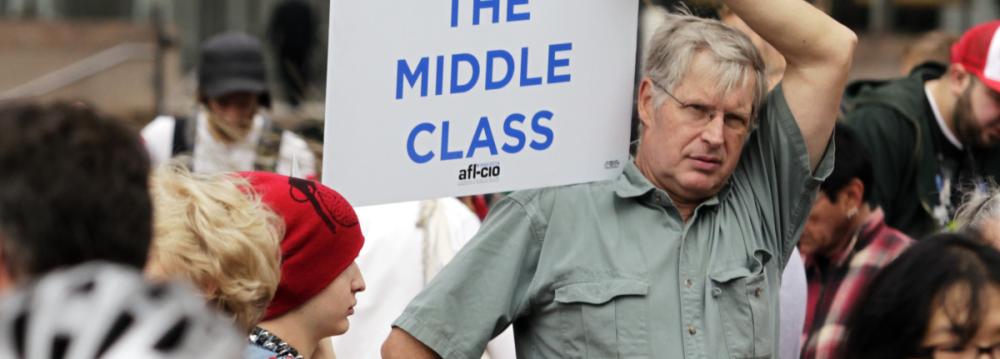A major problem since America’s recovery from the recession has been the quality of jobs that have come back.
For years, growth was strongest in high-wage and low-wage jobs, hollowing out the growth of middle class positions. The decades-long trend of income inequality worsened after the recession, CNNMoney reported.
But the US economy may now be shifting gears toward more middle class jobs.
“The tide has begun to turn,” William Dudley, president of the New York Federal Reserve, said. “For the first time in quite a while, gains in middle-wage jobs actually outnumber gains in higher- and lower-wage jobs nationwide.”
Between 2013 and 2015, the New York Fed found, the economy added 2.2 million middle class jobs. That far outpaced the 1.5 million high-wage jobs added and the 1.6 million low-wage jobs gained during that time.
It’s a sharp reversal from the early years of the recovery from the Great Recession. Between 2010 and 2013, low and high-wage industries hired roughly 2.1 million workers each, while only 1.2 million middle class jobs were added.
Middle class jobs are characterized as workers making approximately $30,000 to $50,000.
Construction, transportation, installation and education jobs have led the charge of good-paying jobs in the past few years.
The New York Fed’s findings come amid a major debate about skills. The US has a near-record number of job openings: 5.6 million.
Recovery Plagued
That’s partially good news—employers are hiring. But it also indicates companies can’t find the workers they need. The “job skills gap” between unemployed workers’ skills and employers’ needs has plagued the recovery.
And it has led to a high-level of part-time jobs: About six million Americans work part-time jobs but want full-time positions.
A decade ago only 4.3 million Americans worked in such unwanted jobs. Still, the recovery in middle class jobs reflects the economy’s gradual improvement. Unemployment peaked at 10% in 2009 and today it is below 5%.
CEOs Complain
The jobs that were lost during (and after) the brutal recession have largely come back. But businesses haven’t felt much pressure to pay workers more. Until now.
The typical wage in America is now $828 a week, according to the Labor Department. During the depths of the Great Recession, weekly wages fell under $730.
CEOs are feeling the political and economic pressure to raise wages. Starbucks, JPMorgan Chase, United Airlines and Walmart all announced pay hikes this year.
Some executives have even started complaining. Chipotle (CMG) blamed higher wages—especially new laws raising the minimum wages to $10, $12 or even $15 an hour in places—for some of its recent slump in profits.
Wage Problem
“The labor inflation especially in the last year has been significant,” said John Hartung, Chipotle’s chief financial officer, on a recent earnings call. “We haven’t passed on the cost of those higher wages (to customers).”
Executives at Cintas, a company that makes work uniforms, said rising wages and new overtime laws “can have a pausing effect on our customers” (meaning they will hurt sales). Walmart warned higher wages and training would lower profits by $1.5 billion this year.
“The upward wage trend is going to continue,” says Randy Frederick, managing director of trading at Schwab. “It will put pressure on earnings.”
The focus now—from Main Street to Wall Street to the campaign trial—is on how much more wages will rise.
Good-paying jobs and healthy wages have been hot topics on the 2016 campaign trail for both Hillary Clinton and Donald Trump. Workers are demanding more money at their jobs, and they finally have some leverage to ask for higher pay since it’s getting harder to find people to fill jobs.
Alarm Bells
Big companies are raising the little guys wages. Wall Street is already alarmed at this trend. CEOs are increasingly getting asked: Will the raises hurt profits and stock prices? Mentions of “wage” or “wages” on earnings calls this quarter have doubled compared to a year ago, according to FactSet.
In order to pay for wage increases, companies have to hike prices on their goods, cut expenses elsewhere or else live with lower profits. For now, most companies appear to be managing by trimming elsewhere. But that won’t be able to go on forever.
“What we want to try and do is really get ahead of any federal or state mandate to be the employer of choice,” Starbucks CEO Howard Schultz said on a recent call with Wall Street analysts who asked why the popular coffee chain is increasing pay by at least 5% an hour in October (that’s about 50 cents, based on the average barista wage listed on Glassdoor.com).
In other words, Schultz was basically admitting: We’re paying more because it’s harder to find good workers. But investors are hearing: Look out, costs are going up. With the US stock market at record highs, investors are weary of anything that would cause stock prices to drop.


